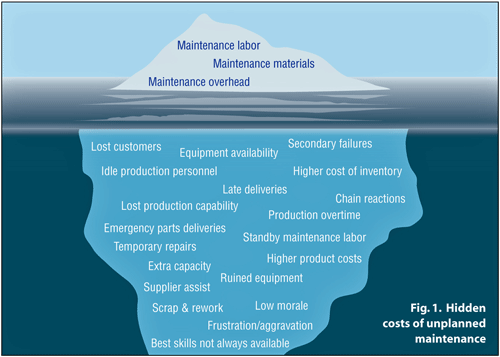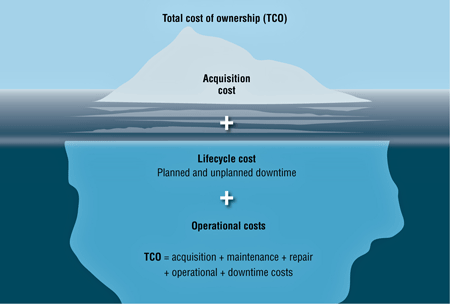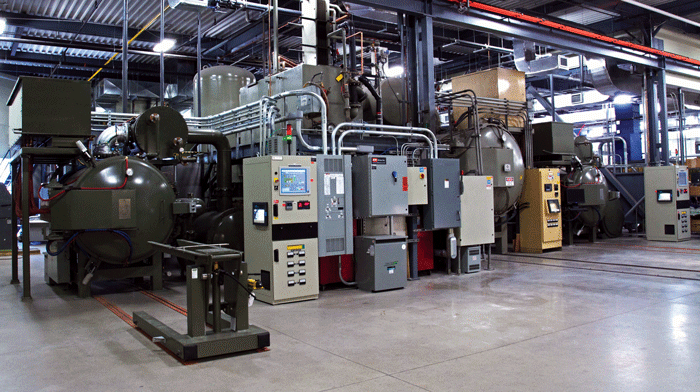“It was only a tiny drop of water, now and then,” lamented the homeowner. “How was I to know that all those little drops would add up to a huge water bill?” The same can be said of a heat treat furnace that is always down for this reason or that. Avoiding the hidden costs associated with equipment downtime is the key to saving money.
Proactive vs. Reactive Strategy
Maximizing furnace productivity requires a proactive approach, which must continue throughout a unit’s operational lifetime. This requires careful planning and anticipation of problems. The process should begin even before the purchase of a piece of equipment by matching equipment and supplier capabilities with production and process needs. Buying good, well-built, high-quality equipment and operating and maintaining it properly will avoid most hidden costs.

Overall equipment efficiency (OEE) is a measure of how effectively your equipment runs when you plan to run it. OEE is availability times performance efficiency times rate of quality. Here, availability is the percentage of scheduled time that the operation is available to operate (available time divided by scheduled time).
Overall Equipment Efficiency
For example, suppose a work center is scheduled to run for a 435-minute shift. However, the work center experiences 30 minutes of unscheduled downtime. The available time equals 435 minutes (scheduled time) minus 30 minutes (downtime), or 405 minutes. The availability is 405 minutes divided by 435 minutes or 93%. Not bad, or so you think.
Now, let’s look at performance. Performance represents the speed at which the work center runs as a percentage of its designed speed. In other words, parts produced times ideal cycle time divided by available time.
Continuing our example, if the available time is 405 minutes and the standard rate for the part being produced is 40 units per hour (or 1.5 minutes per unit), then the work center produces 242 total units during the shift. If the time to produce the parts (242 units times 1.5 minutes per unit) is 363 minutes, then the performance is 363 minutes divided by 405 minutes or 90%. Again, not bad, or so you think.
Now, let’s consider quality. Quality represents the good units produced as a percentage of the total units started or good units divided by units started.
Continuing our example, if a given work center produces 230 good units during a shift, of the 242 units that were started, the quality equals 230 good units divided by 242 units started, or 95%. Again, not bad, or so you think.
Now, let’s calculate the OEE. In our example, OEE = 93% (availability) x 90% (performance) x 95% (quality) = 79.5%. This tells us that our efficiency is not what we should expect, and improvement is needed and warranted.
Anticipatory Maintenance Planning
As with any good maintenance operation, finding and eliminating problems even before they occur is part of a proactive approach (Fig. 1). The trend today is toward planned preventive-maintenance programs so that manufacturing output remains consistent. Some strategies use:
- Component usage-time monitoring (via hour meters)
- Critical spare-parts identification (on or off-site inventories)
- Analysis of detailed operational and maintenance records
- Root-cause determination (when problems occur)
- A complete explanation of repairs (why, what, where, when and how)
![Fig. 2. The effects of manufacturing downtime[1].](https://vacaero.com/wp-content/uploads/2013/01/effects-manuf-downtime_md.gif)
Planned preventive-maintenance programs also allow those involved with the equipment to:
- Understand the external constraints imposed by issues such as equipment usage, operator experience, and budgetary constraints.
- Understand how the equipment must be serviced, asking questions such as:
- How should the equipment operate?
- How is it working now?
- Tailor the plan to meet realistic expectations.
- Identify necessary spares and have them in stock.
- Understand which spares must come from an OEM provider and which can be purchased from third-party suppliers.
- Divide the work effort into small areas serviced by specific disciplines.
- Focus on those components or assemblies (internal or external) that are critical to the functionality of the operation.
- Do an exterior and interior review and observe how components function and interact.
- Put the repair information into a usable (i.e. searchable) and retrievable form in order to:
- Review needs with management.
- Get feedback through team meetings.
- Revise the plan as needed.
- Establish a mean time between failures for key components.
- Conduct cause-and-effect analyses.
- Determine the root cause of a failure (don’t just fix the obvious).
- Be disciplined.
- Realize the benefits of having a carefully structured, rigorously adhered to program (this is not punishment but prevention). In other words, do the job right, do the job on-time and have the tools and supplies on hand to succeed.
Scheduled maintenance can also aid in the reduction of nonconforming production parts (i.e. scrap). Unacceptable parts are often the catalyst for unplanned downtime (Fig. 2). By being proactive in your maintenance plans, you should be able to minimize defective parts.
Hidden Costs of Downtime
Having reliable equipment directly relates to minimizing downtime. The key factor to consider when looking for a heat-treat furnace is understanding the True Equipment Cost (TEC), which equates to the initial investment plus the total cost to maintain (over time) divided by equipment life expectancy. In the heat-treat world, this is often 30-50 years!

When considering the purchase of new manufacturing equipment, initial purchase cost should not be the only factor to consider, nor necessarily the most important factor in determining what to buy. In addition to the initial cost of the equipment, there are other criteria that should be factors in the decision, namely
1. Total equipment cost – This alone provides the true picture. When analyzing the cost to purchase, one must include not only the initial investment but also the costs to operate and maintain. This involves understanding the utilized capacity of the machine in terms of utilities, manpower, component parts, energy, and environmental factors. Recognize that all equipment experiences downtime, whether planned or unplanned, but the amount of downtime is most often dictated by the robustness of the equipment and the responsiveness of those that service it (more on this later).
Dependability must be an integral part of the business decision. Ask questions such as: Will the equipment be reliable and available on a consistent basis? Will it produce quality parts, safely, while maintaining maximum uptime?
2. Equipment and process compatibility – Meeting process requirements is a necessity that existing or new equipment must achieve. Lengthening cycles or compensating for design deficiencies is unacceptable. Equipment that fails prematurely or experiences processing problems or unplanned interruptions in production costs time and money. Environmental safety should also be a consideration because we can expect more regulations as time goes on.
When equipment design reflects process requirements, optimal production capacity can be achieved. Understand if you are buying a heavy-duty or light-duty furnace and plan accordingly. Heavy-duty furnaces can be pushed up to (and often exceeding) manufacturer’s limits while light-duty equipment typically cannot.
Uptime availability in the heat-treat industry is typically 85%, and in some (rare) instances approaches 90% and above. Do not expect more out of your system than you are willing to put into it. Costs associated with unplanned downtime may be 1-3% of asset value per year.
Other factors to consider in the equipment purchase are how you believe your processes and capacity demands will change over time. Because we live in a customer-driven market, we can be assured that demands will change. Will the equipment be capable of meeting these changes in the future?

3. Educate the workforce – Training plays an important part in bottom-line profitability. Whether it is the operators, supervisors, engineers or maintenance staff, everyone needs to understand their product, how it is being heat treated and the equipment in which the process takes place. In this way, the support staff (including quality and purchasing) can participate more effectively when something goes wrong.
A well-educated staff enables a company to achieve the fastest, most cost-effective solution to the problem. Training and experience help analyze the problem quicker, determine a solution and communicate a plan of action for service personnel to implement. This process takes time and commitment on the part of management.
4. Apply automation and advanced controls – Smart adaptation of automation, historical record-keeping and the ability to adapt to the changing needs of heat treating can increase profitability with only incremental investment costs. Automation takes the human element out of the operating equation, but humans are needed to select and design smart automation systems, which means that sensors and control devices must also be part of the planning process.
5. Avoidance of excess inventory and WIP – To compensate for poor equipment performance, one often builds additional work-in-process inventory. Costs associated with doing so, and often maintaining these increased levels for months or years, can be the difference between being profitable or incurring a loss. Knowing when scheduled maintenance will occur allows you to manufacture parts before your equipment goes down. One can build just enough inventory to make up for short-term interruptions and avoid long-term surprises. However, this assumes that maintenance can be done without discovering or creating additional problems. If these occur, furnaces are down for extended periods as companies struggle to identify the source of a new problem or fix the result of a malfunction or catastrophe.
6. Cost of emergency parts purchases – If an unplanned failure occurs, it is imperative to get the heat-treat equipment operational as quickly as possible. This will involve getting the necessary parts to repair the equipment. It also entails costs to install and the cost of expedited shipping. All of these increase the cost of manufacturing even though production is at a standstill. Having the right match of features and components on the furnace and having a primary and secondary (sometimes tertiary) supply chain can avoid huge cost overruns.
7. Overtime and outsourced production – During the time of an unplanned shutdown, you will still need parts. If other equipment can be used to produce those parts, overtime for manufacturing personnel may be required. This will also increase utility costs and may produce bottlenecks within the manufacturing process. If there is no other available equipment to use for production, it may be necessary to outsource your production to another party. This may jeopardize your promised delivery to your customer, and it will certainly increase your costs.
8. Total cost of ownership (Fig. 3) – Lost revenue due to downtime is a huge factor in determining the total cost of ownership (TCO). Cost of operation (life-cycle cost), maintenance and repair costs as well as the cost impact of unplanned downtime all factor into TCO. If the issues causing downtime are not corrected quickly and efficiently, they may lead to the loss of your customer, which ultimately means the loss of market share. The heat-treat industry is a competitive market, so you don’t want unplanned downtime affecting your customer base.
Things mechanical and things electrical can be fixed. As we say in the industry, we can throw enough money at these problems, and eventually, we can solve them. However, no amount of money can overcome a mismatched process. When process and equipment are not fully compatible, it will have an impact on the quality of the parts being produced.
9. Cost of product failure – Ever wonder why we always have enough time to reprocess, but never seem to have enough time to do the task right the first time? Product failures, especially those that escape the plant and make their way into the field, are devastating. These are true hidden costs that must be considered when selecting vendor partners.
10. Impact of equipment deterioration over time – Everything wears out, and all furnace components have a finite life and must be replaced. We know this and plan for it. When the same components repeatedly fail or the same systems break down time after time, only then do we become aware of the consequences of a poor equipment choice. Premature replacement of component parts adversely affects the bottom line. Determining the root cause of these types of problems must be priority one, and avoiding Band-aid fixes is an absolute necessity.
11. Making wrong assumptions – Too often, the most overlooked areas of an equipment purchase are the service and support that your supplier will provide. Given the complexity of today’s heat-treat equipment, your supplier partner must be prepared to walk you through the discovery process to determine why something went wrong; understand what happened; understand what needs to be done to fix it, and help plan and execute its repair.
Record keeping or maintenance logs, for example, should not be written with today in mind. They should tell a story that years later someone can understand and learn from when (not if) a similar problem reoccurs. Remember, the knowledge and expertise of your OEM is often the determining factor in the length of your downtime and the minimization of lost profits. So, keeping them informed of your current equipment and the lessons learned will not only benefit you but the industry as a whole.
12. Look for the overlooked – Uptime utilization is the goal in today’s cost competitive and technology-driven world. To streamline the manufacturing process, flexibility is required. One must ask questions such as: Do furnace pits make sense, or is it wiser to integrate heat treating into the manufacturing flow?
Design and/or material defects can cause unnecessary direct costs (e.g., labor, materials) while fabrication, assembly or installation deficiencies can produce unwanted delays, all causing a hit to bottom-line profitability. Other potential threats that can cause diminished returns are operator or maintenance errors. When these factors are examined prior to equipment purchase and plans are created to supplement the skills of the workforce, there is a better chance of minimizing production costs and maximizing throughput.
13. Be logical – Having a blank check to purchase heat-treat equipment is a rare commodity. Every company wants to get the most value for the least dollar, but not all equipment is created equal. It’s important to understand that an equipment purchase is a complicated process – one that should be given adequate time to evaluate the hidden costs as well as the obvious costs. For example, the life expectancy of heat treat equipment varies, but no matter what the equipment’s duty lifetime, you will need to partner with your supplier through its entire life. Ask yourself questions such as: Will the OEM be there to support you long-term, and are they committed (and staffed) with proper engineering and service support? Be sure you and your supplier agree on costs (both initial and ongoing), level of service and support, and mutual expectations.
14. Separate needs from wants – It is important to examine what the company’s needs are today and then project an estimate of future needs. The goal is to purchase equipment that is not only capable of meeting today’s production capacity but is versatile enough to meet tomorrow’s challenges as well. In many cases, the materials, processing requirements and load sizes change, but the equipment features do not. Therefore, building in and paying for flexibility up front will result in long-term cost savings.
Vacuum-Furnace Example
Vacuum furnaces (Fig. 4) are a prime example of a sophisticated purchase. As such, it is incumbent on vacuum-furnace manufacturers to provide rapid support capability. They should be an integral part of resolving equipment problems. This can be accomplished by such simple means as dedicated phone lines at the equipment for connection by OEM engineers, Internet troubleshooting, rapid-response teams, inventory of critical spares by the OEM, advanced diagnostic tools and well-trained engineering and service personnel.
The Bottom Line
OEMs need to differentiate themselves by their support, service, speed, and thoroughness. All of which helps their customers avoid the hidden costs of downtime. Many times low-priced, light-duty furnaces with poor support ultimately cost more to own and operate. Supplier partners who lack “critical velocity” or who are unwilling or unable to assist add cost to the user rather than save money in the long run. Doing the small things – such as managing and coordinating parts or having personnel, assets, and resources at the ready – make worthy vendor partners who save money by maximizing furnace uptime productivity.
References
- Charky, Alan – VAC AERO International Inc.
- Fitchett, Don and Mike Sondalini, True Downtime Cost Analysis, Business Industrial Network (www.bin95.com)
- Drive Your Succe$$ (www.driveyoursuccess.com)
- Bell, Donald R., “The Hidden Cost of Downtime: A Strategy for Improving Return on Assets,” Maintenance Technology, July 2001.
- Downtime Central (www.downtimecentral.com).
